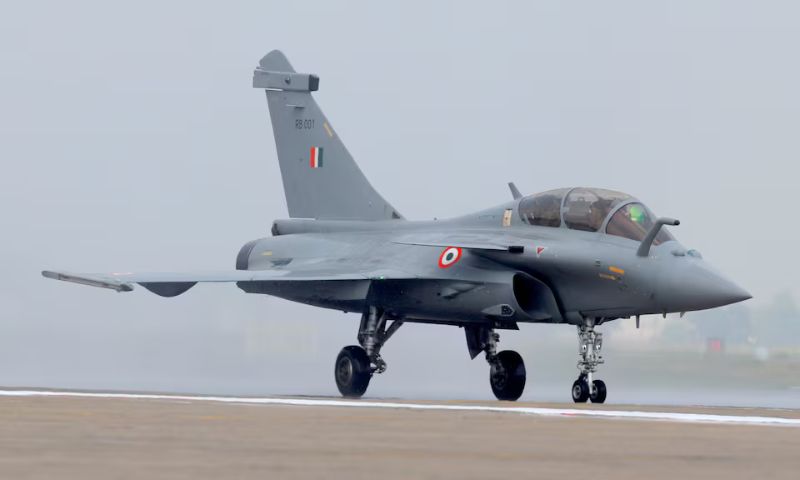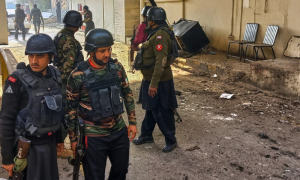KEY POINTS
- Pakistan downed Indian Rafale jet during a major air battle on 7 May, marking the first confirmed loss of the French-made fighter.
- Over 110 aircraft were involved, making it one of the largest air battles in decades.
- Faulty Indian intelligence underestimated the range of Pakistan’s PL-15 missile, allowing a J-10C to strike the Rafale.
- Pakistan used a multi-domain “kill chain” system to link air, land, and space sensors, enhancing battlefield awareness.
ISLAMABAD: Just after midnight on 7 May, the operations room of the Pakistan Air Force (PAF) lit up with red markers indicating dozens of Indian fighter jets across the border.
Pakistan’s Air Chief Marshal Zaheer Sidhu, who had been sleeping on a mattress nearby the operations room for days in anticipation of an Indian assault, immediately sprang into action, Reuters reported.
New Delhi had blamed Islamabad, without providing any evidence, for backing militants who carried out an attack on April 22 in the Pahalgam area of Indian Illegally Occupied Kashmir, which killed 26 people. Pakistan condemned the attack and strongly rejected Indian allegations as baseless.
Islamabad also offered a transparent and independent international investigation into the Pahalgam incident. However, India failed to respond to Pakistan’s offer and continued its aggressive posture. In the early hours of May 7, India launched air strikes on Pakistan.
Air Chief Marshal Sidhu ordered Pakistan’s prized Chinese-made J-10C jets to scramble. A senior Pakistani Air Force (PAF) official, who was present in the operations room, cited by Reuters, said the air chief instructed his staff to target Rafales, a French-made fighter that is the jewel of India’s fleet and had never been downed in battle.
“He wanted Rafales,” said the official as quoted by Reuters.
The hour-long fight, which took place in darkness, involved some 110 aircraft, experts estimate, making it the world’s largest air battle in decades.
Rafale down
The J-10s shot down at least one Rafale, Reuters reported in May, citing US officials. Its downing surprised many in the military community and raised questions about the effectiveness of Western military hardware against untested Chinese alternatives.
Shares of Dassault, which makes the Rafale, dipped after reports the fighter had been shot down. Indonesia, which has outstanding Rafale orders, has said it is now considering purchasing J-10s — a major boost to China’s efforts to sell the aircraft overseas.
But Reuters interviews with two Indian officials and three of their Pakistani counterparts found that the performance of the Rafale wasn’t the key problem: Central to its downing was an Indian intelligence failure concerning the range of the China-made PL-15 missile fired by the J-10 fighter.
China and Pakistan are the only countries to operate both J-10s, known as Vigorous Dragons, and PL-15s.
Faulty intelligence
The faulty intelligence gave the Rafale pilots a false sense of confidence they were out of Pakistani firing distance, which they believed was only around 150 km, the Indian officials said, cited by Reuters, referring to the widely cited range of PL-15’s export variant.
“We ambushed them,” the PAF official said, adding that Islamabad conducted an electronic warfare assault on Delhi’s systems in an attempt to confuse Indian pilots. Indian officials dispute the effectiveness of those efforts.
“The Indians were not expecting to be shot at,” said Justin Bronk, air warfare expert at London’s Royal United Services Institute (RUSI) think-tank. “And the PL-15 is clearly very capable at long range.”
The PL-15 that hit the Rafale was fired from around 200km away, according to Pakistani officials, and even farther according to Indian officials. That would make it among the longest-range air-to-air strikes recorded.
India’s defence and foreign ministries did not return requests for comment about the intelligence mistakes, Reuters stated.
Professional preparedness
Delhi hasn’t acknowledged a Rafale being shot down, but France’s air chief told reporters in June that he had seen evidence of the loss of that fighter and two other aircraft flown by India, including a Russian-made Sukhoi.
A top Dassault executive also told French lawmakers that month that India had lost a Rafale in operations, though he didn’t have specific details.
Pakistan’s military referred to past comments by a spokesperson who said that its professional preparedness and resolve was more important than the weaponry it had deployed.
Not only did Islamabad have the element of surprise with its missiles’ range, the Pakistani and Indian officials said, cited by Reuters, but it managed to more efficiently connect its military hardware to surveillance on the ground and in the air, providing it with a clearer picture of the battlefield. Such networks, known as “kill chains,” have become a crucial element of modern warfare.
Four Pakistani officials said they created a “kill chain,” or a multi-domain operation, by linking air, land and space sensors.
The network included a Pakistani-developed system, Data Link 17, which connected Chinese military hardware with other equipment, two Pakistani officials said as cited by Reuters.
The system allowed the J-10s flying closer to India to obtain radar feeds from the surveillance plane cruising further away, meaning the Chinese-made fighters could turn their radars off and fly undetected, according to experts, cited by Reuters.
Delhi is trying to set up a similar network, the Indian officials said, adding that their process was more complicated because the country sourced aircraft from a wide range of exporters.
Retired UK Air Marshal Greg Bagwell, now a fellow at RUSI, said the episode didn’t conclusively prove the superiority of either Chinese or Western air assets but it showed the importance of having the right information and using it.
“The winner in this was the side that had the best situational awareness,” said Bagwell.
Change in tactics
After India in the early hours of May 7 struck Pakistan, Sidhu ordered his squadrons to switch from defence to attack.
Five PAF officials said India had deployed some 70 planes, which was more than they had expected and provided Islamabad’s PL-15s with a target-rich environment. India has not said how many planes were used.
The May 7 battle marked the first big air contest of the modern era in which weaponry is used to strike targets beyond visual range, said Bagwell, noting both India and Pakistan’s planes remained well within their airspaces across the duration of the fight.
Five Pakistani officials said an electronic assault on Indian sensors and communications systems reduced the situational awareness of the Rafale’s pilots.
India’s defence attaché in Jakarta told a university seminar that Delhi had lost some aircraft “only because of the constraint given by the political leadership to not attack [Pakistan’s] military establishments and their air defences.”
India’s chief of defence staff General Anil Chauhan previously told Reuters that Delhi quickly “rectified tactics” after the initial losses.

























